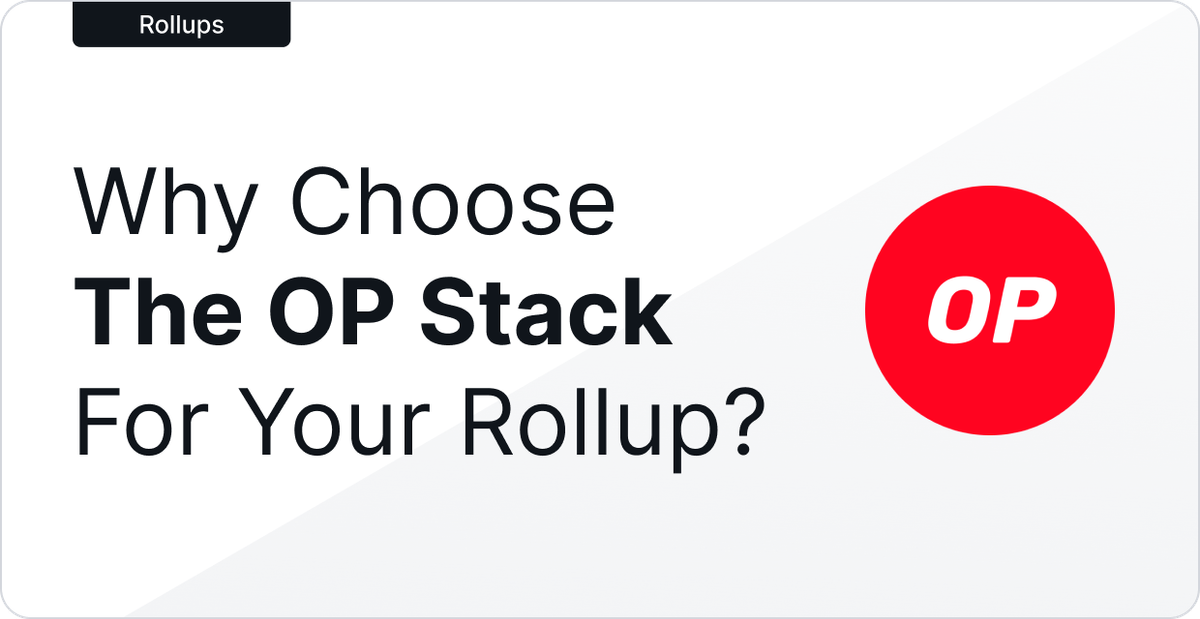NEW: OP Stack Rollups — Deploy On Web3's Most Reliable Infra
In this blog, we’ll explore the OP Stack from Optimism, its architecture, and the Superchain philosophy, and help you evaluate if the OP Stack is the right choice for your rollup development.

Great news!
Rollups are now easier than ever to build.
Here's why:
Thanks to solutions like QuickNode's Rollups and frameworks such as the OP Stack, zkSync Elastic Chains, and Arbitrum Orbit, the complexities of rollup development have been significantly simplified.
Now, anyone can effortlessly launch their own enterprise-grade rollup in minutes, scale higher on the most reliable infrastructure, amplify the growth of an engaged ecosystem with global distribution to high-intent developer communities, and unlock new opportunities to generate valuable new revenue streams from their rollup.
For builders considering which of the leading frameworks to choose for their rollup stack, the OP Stack is worth noting for its ambitious vision for the Superchain. That's because the OP Stack is more than just a technical framework—it's a blueprint for creating a more interconnected, efficient, and scalable blockchain ecosystem.
So, let's unpack the OP Stack, its architecture, and the Superchain philosophy, and help you decide if the OP Stack is the right choice for your rollup.
The OP Stack: Unpacked
The OP Stack is a modular, open-source framework designed by Optimism to create scalable and interoperable Layer 2 (L2) blockchains, known as OP Chains. The latest version, Optimism Bedrock, focuses on simplifying the deployment process for new L2 rollups.
At its core, the OP Stack is an open-source, modular framework designed by Optimism to build scalable and interoperable Layer 2 (L2) blockchains, known as OP Chains.
The current iteration, Optimism Bedrock, focuses on simplifying L2 rollup deployment while maintaining flexibility for developers.
To see how it does this, let's dive into the architecture of the OP Stack.
The OP Stack has five layers:
- Sequencing Layer: Manages transaction ordering, ensuring efficient and predictable execution. This layer enhances dApp performance and offers the flexibility to choose between single or multiple sequencers.
- Data Availability (DA) Layer: Stores and publishes the raw data necessary for transaction validation and processing. While Ethereum serves as the default DA solution, the OP Stack's modularity allows for alternative options like Celestia to balance cost and performance. Learn about the top data availability solutions here.
- Derivation Layer: Structures raw data for execution, maintaining blockchain state consistency and security.
- Execution Layer: Processes transactions and updates the blockchain state, offering full compatibility with the Ethereum Virtual Machine (EVM). This enables seamless integration of existing Ethereum-based dApps while providing the flexibility to use other execution environments.
- Settlement Layer: Ensures secure verification of rollup state transitions by Ethereum, typically handling withdrawal processes and enabling third-party chains to verify the target chain's state.
This layered architecture allows developers to customize specific components without overhauling the entire system, simplifying rollup development with a ready-to-use framework while maintaining the flexibility to adapt to individual project needs.
Building upon this layered architecture, the next major scalability improvement to the OP Stack after Bedrock was introducing the concept of a Superchain.
The Superchain: A New Vision Of Scalability
Simply put, the Superchain is a network of interconnected OP Chains built on the OP Stack, sharing open-source infrastructure, standardized security protocols, a unified communication layer, and built-in bridging.
Three core principles guide the Superchain philosophy:
- Homogeneity: Ensures consistent behavior and performance across all OP Chains.
- Neutrality: Maintains decentralization and permissionless access, providing equal resources for all users and developers.
- Openness: Encourages innovation and collaboration while preventing centralization of control over blockspace.
The Superchain ecosystem enhances Optimism's mission to scale Ethereum. Here are four reasons why this environment is particularly appealing to developers:
- Horizontal Scalability: Superchain enables multiple OP Chains to operate in parallel without sacrificing security or performance.
- Native Interoperability: It facilitates seamless asset and data transfer across different OP Chains, which is essential for developing complex cross-chain applications and improving user experience.
- Superchain Bridge: A shared bridge governs all OP Chains, with upgradable features by the Optimism Collective to ensure transaction security and liveliness. Users can easily migrate to a new chain if an OP Chain sequencer misbehaves.
- Future-proof Development: All OP Chains follow a common upgrade path managed by a decentralized security council, ensuring consistent security properties and reducing systemic risks associated with traditional multi-chain architectures.
The Superchain represents a significant step toward a horizontally scalable, secure, and decentralized web. For developers, the potential network effects and collaborative ecosystem offered by the Superchain make building rollups using the OP Stack an attractive choice.
To build upon that, let's cover some of the most compelling reasons to choose the OP Stack as the framework for your Rollup.
OP Stack + Your Rollup: 5 Reasons
Here are five compelling reasons why the OP Stack is an excellent choice for developers looking to build rollups:
- EVM Compatibility: The OP Stack boasts near-full compatibility with EVM, making it easy for developers familiar with Ethereum to migrate existing dApps with minimal changes. This compatibility accelerates the time-to-market for new projects.
- Intuitive Development: The OP Stack is designed to be developer-friendly. It simplifies processes with features like a single sequencer that automatically orders and processes transactions, eliminating the need for separate provers or complex proof systems.
- Interoperability through the Superchain Vision: By utilizing the OP Stack, developers participate in a forward-thinking ecosystem that promotes seamless cross-chain communication, shared liquidity, and effortless interaction among rollups.
- Flexible Finality Options: The OP Stack offers customizable finality features, including both instant "soft finality" and secure "hard finality" options. This flexibility allows developers to tailor their applications according to their specific needs. For example, gaming and prediction market dApps may prefer soft finality, while decentralized exchanges (DEXs) or lending protocols might opt for hard finality.
- Cost-efficient Development: The OP Stack employs calldata for storing L2 transaction data, a smart approach that minimizes costly on-chain state modifications. This strategy enables dApps to function more economically while still benefiting from Ethereum's security.
Notable Projects Built Using the OP Stack
Here are several notable projects that have already embraced the OP Stack and developed on it:
- Zora Network: An NFT ecosystem providing creators with tools to bring art and culture on-chain, making NFT minting smoother and more accessible.
- Base: An Ethereum L2 platform designed for building on-chain applications, which quickly gained over 100,000 users within 56 days of launch.
- Worldcoin: A digital identification platform that enables users to verify their online identity using the OP Stack for reduced fees and faster transactions.
- opBNB Network: A layer 2 scaling solution for the BNB Smart Chain that utilizes the OP Stack’s modular design for optimized performance and decentralization.
- 3DNS: A decentralized domain registrar that tokenizes domain names for user control, benefiting from lower gas fees thanks to the OP Stack.
- Farcaster: A decentralized social media platform that efficiently handles a large transaction volume, ensuring smooth user experiences.
- DeBank: A DeFi platform that manages crypto assets across various protocols, leveraging Optimism's Bedrock upgrade to lower transaction fees significantly.
OP Stack + QuickNode: The Right Way To Rollup
The OP Stack provides a modular, open-source framework that simplifies the development of scalable Layer 2 blockchains. It empowers developers to build and customize Layer 2 rollups by seamlessly integrating various execution, data availability, and settlement layers while benefiting from Ethereum's robust security.
QuickNode enhances building on the OP Stack by offering industry-leading infrastructure to deploy, scale, and manage your rollups effortlessly.
- Comprehensive API Infrastructure: Access a robust blockchain API infrastructure that streamlines rollup development and management.
- Enterprise-grade Performance: Achieve maximum performance with zero downtime and seamless scalability, regardless of network demand.
- Global Distribution: Ensure fast and reliable access for users across regions with globally distributed infrastructure.
- Native Block Explorers: Utilize built-in block explorers like BlockScout for easy transaction history searches and on-chain data management.
- Testnet Faucet: Access testnet faucets for funding accounts and testing contract deployments, simulating real-world use cases.
- Interoperability with OP Superchain: Enable efficient interactions with other Layer 2 networks through full integration with the OP Superchain.
- Customizable Rollup Tooling: Fully customize and optimize your rollups using QuickNode’s reliable infrastructure and tools.
- High Uptime SLAs: Benefit from a guaranteed 99.99% uptime, ensuring smooth and consistent rollup performance.
By leveraging the OP Stack with QuickNode, developers can unlock the full potential of rollup development and contribute to a more scalable and interconnected blockchain ecosystem.
With support for leading protocols like OP Superchain, QuickNode takes care of the technical heavy lifting so you can concentrate on creating great user experiences and efficiently bringing your product to market.
See how easy it is to deploy and manage your rollup with QuickNode:

Get Started Today – Visit the QuickNode Dashboard to deploy your rollup and experience the future of blockchain scalability. Contact Us, and let’s build the future of your chain together.
Enhance your existing Rollup with
QuickNode's Enterprise-Grade Infrastructure
Unlock superior performance, reliability, and cost-efficiency by integrating your existing rollup with QuickNode's industry-leading RPC infrastructure. Discover how QuickNode can transform your rollup experience, providing unparalleled support and scalability.
Simply click the button and fill out the form below to discuss how we can enhance your existing Rollup together:

About QuickNode
QuickNode is building infrastructure to support the future of Web3. Since 2017, we've worked with hundreds of developers and companies, helping scale dApps and providing high-performance access to 30+ blockchains. Subscribe to our newsletter for more content like this, and stay in the loop with what's happening in web3!





